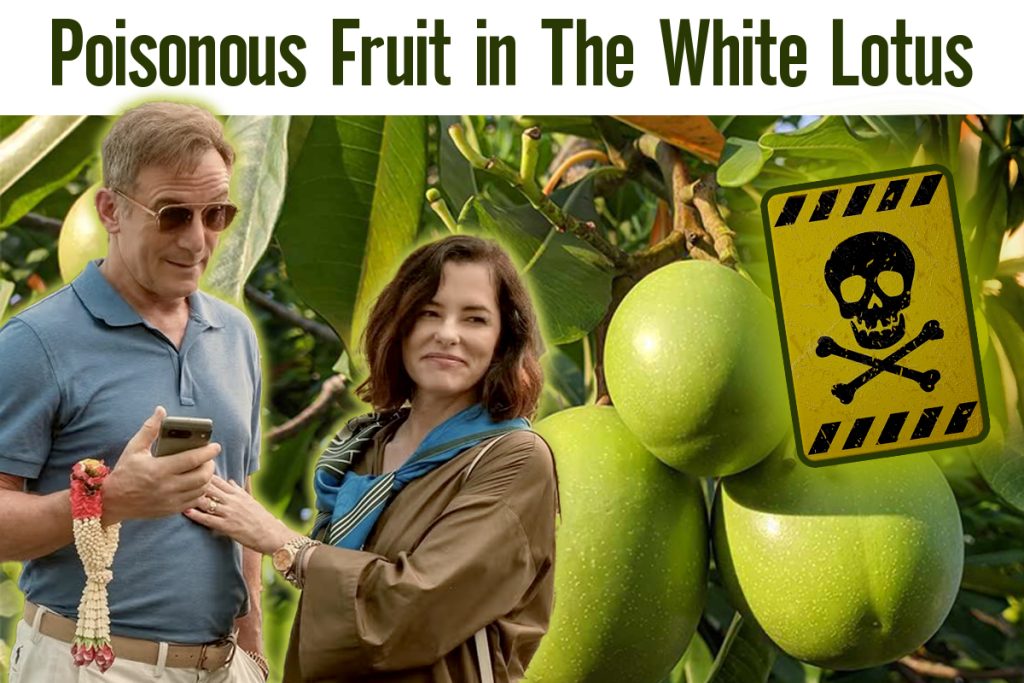In the critically acclaimed HBO series The White Lotus, symbolism plays a major role in shaping the story. It also adds depth to the characters. One recurring motif that fascinates viewers is the idea of poisonous fruit. This subtle yet powerful symbol hints at danger, deception, and hidden darkness. It reflects the uneasy truths beneath the surface of seemingly perfect situations.
The Symbolism of Poisonous Fruit
Throughout The White Lotus, the setting of the luxurious resort in Hawaii serves as a metaphor for paradise, but beneath the surface lies a brewing storm of tensions and hidden motives. The poisonous fruit is a symbol of temptation, often appearing as something sweet and desirable, yet harmful once consumed. It represents the allure of indulgence and the risks that come with it. Just like the fruit that seems safe to eat but proves deadly, the characters in The White Lotus are often drawn into situations that seem perfect on the surface, but harbor darker consequences.
The Role of Poisonous Fruit in Key Storylines
While the show never explicitly references “poisonous fruit” in the literal sense, its story reflects that symbolism. The characters, often wealthy and privileged, chase desires rooted in power, control, and pleasure. Eventually, they must face the consequences of those choices.
At the White Lotus resort, their obsession with luxury pulls them into morally gray situations. Here, betrayal, secrets, and manipulation hide beneath the surface of paradise.
Tanya (played by Jennifer Coolidge) especially embodies this metaphor. Her search for love and belonging stems from deep emotional emptiness. Like a poisoned fruit, her desires lead her into toxic and harmful relationships.
Other characters reflect similar themes. The Mossbacher family’s dysfunction reveals how polite conversation can mask deeper conflict. What seems innocent often hides betrayal or emotional neglect.
Poisonous Fruit as a Warning
The idea of poisonous fruit in The White Lotus also serves as a cautionary tale for the characters and viewers alike. It warns of the risks involved in yielding to temptation and ignoring the potential harm of indulgence. Just like the resort guests who expect pampering and constant service, they eventually face the real cost of their indulgence in surprising ways.
From the opening scene—where someone discovers a body at the resort—to the unfolding betrayals and moral compromises, The White Lotus skillfully builds tension through powerful symbolism. By the end of the series, the paradise they once believed in collapses, exposing the toxic consequences of their own choices.
Conclusion
In The White Lotus, the poisonous fruit is more than just a plot device. It serves as a powerful metaphor. The show explores greed, deception, and the hidden darkness of human nature. As characters chase their desires, they soon face the consequences. The metaphorical fruit becomes more dangerous than they ever imagined.
Like the guests at the White Lotus resort, we’re reminded of a deeper truth. Not everything that appears sweet is safe to consume.
FAQs:
What does the poisonous fruit symbolize in The White Lotus?
The poisonous fruit in The White Lotus symbolizes temptation, deception, and the hidden dangers lurking beneath seemingly perfect situations. It represents the allure of indulgence and the consequences that come with ignoring the potential harm.
How does the poisonous fruit metaphor relate to the characters in The White Lotus?
The metaphor of poisonous fruit is seen in the characters’ desires and actions. Much like the fruit that appears harmless but is dangerous, the characters in The White Lotus are drawn into situations that seem perfect but ultimately result in betrayal, moral compromises, and darker consequences.
Which character in The White Lotus embodies the poisonous fruit metaphor?
Tanya (played by Jennifer Coolidge) personifies the poisonous fruit metaphor. Her search for love and acceptance leads her into dangerous relationships, mirroring the idea of indulging in something seemingly sweet but ultimately harmful.
Is there a literal poisonous fruit in The White Lotus?
While there is no literal poisonous fruit in The White Lotus, the metaphorical fruit represents the characters’ indulgences and temptations that lead to harmful outcomes. The series uses this symbolism to explore deeper themes of human nature, deception, and morality.
How does the poisonous fruit metaphor warn viewers in The White Lotus?
The poisonous fruit metaphor serves as a cautionary tale, warning viewers about the dangers of yielding to temptation and the hidden costs of indulgence. It highlights how the seemingly perfect situations often conceal darker truths and consequences.
What is the significance of the poisonous fruit in the series’ overall theme?
The poisonous fruit plays a central role in The White Lotus’ exploration of greed, deception, and the darker side of human desires. It emphasizes that paradise, whether material or emotional, often has a hidden cost that may be poisonous to those who indulge in it.
Where can I read more symbolic breakdowns of popular shows like The White Lotus?
You can explore detailed analyses and symbolic breakdowns of trending series like The White Lotus on our CyberMart Blog, where we dive into deeper meanings behind shows, characters, and key moments.
What is CyberMart.com, and how can I shop there?
CyberMart.com is a leading online eCommerce marketplace in the USA, offering a wide range of products including electronics, fashion, home essentials, and more — all with secure shopping and fast delivery options.



